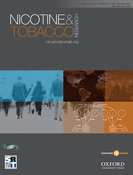-
Views
-
Cite
Cite
James Balmford, Ron Borland, How Do Smokers Use a Smoking Cessation Text Messaging Intervention?, Nicotine & Tobacco Research, Volume 16, Issue 12, December 2014, Pages 1586–1592, https://doi.org/10.1093/ntr/ntu111
Close - Share Icon Share
Abstract
Mobile-phone-based text (SMS) messaging is an effective method for delivering smoking cessation assistance; however, little is known about optimal program use. This paper reports on the use of 2 forms of interaction (reporting changes in quit status and emergency help) among users of QuitTxt, an interactive, automated text messaging advice program. We examined preferences for messaging intensity, duration of use, and their associations with short-term cessation outcome or perceived helpfulness.
QuitTxt was offered during participation in a previously reported randomized controlled trial and was activated by 924 smokers or recent quitters, of whom 862 used it to a criterion level. Outcome data (quit attempts, 7-day point prevalence abstinence, and perceived helpfulness) were collected 1 month after first use.
Most (68.9%) accepted the default of 4–8 messages per day, and median use duration was 27 days. Half (49.1%) appeared to miss reporting at least 1 status change, with relapses less likely to be reported than quit progression. Emergency help was used by 27.0% of those eligible for it; emergency help was used more frequently among those with recent quit experience and lower nicotine dependence. Use of emergency help was unrelated to short-term cessation outcome.
The most notable finding is the variability in use. Some users complied fully with the requirement to report status changes, while even among those who did not, many found QuitTxt to be very helpful, suggesting that perfect congruence between message content and quit status is not essential. The use of emergency help functionality was relatively rare but was appreciated.






Comments